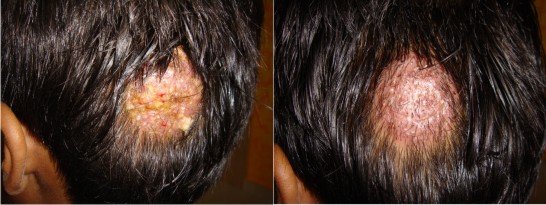
BACTERIAL INFECTION
WHAT IS BACTERIAL INFECTION?
The skin provides a remarkably good barrier against bacterial infections. Although many bacteria come in contact with or reside on the skin, they are normally unable to establish an infection. When bacterial skin infections do occur, they can range in size from a tiny spot to the entire body surface. They can range in seriousness as well, from harmless to life threatening.
Bacterial skin infections develop when bacteria enter through hair follicles or through small breaks in the skin that result from scrapes, punctures, surgery, burns, sunburn, animal or insect bites, wounds, and preexisting skin disorders. People can develop bacterial skin infections when participating in a variety of activities, for example, gardening in contaminated soil or swimming in a contaminated pond, lake, or ocean.
TYPES OF BACTERIAL INFECTION
Cellulitis: Cellulitis is a common and sometimes painful bacterial skin infection. It may first appear as a red, swollen area that feels hot and tender to the touch. The redness and swelling can spread quickly. It most often affects the skin of the lower legs, although the infection can occur anywhere on a person’s body or face. Cellulitis usually happens on the surface of the skin, but it may also affect the tissues underneath. The infection can spread to your lymph nodes and bloodstream. If you don’t treat cellulitis, it could become life threatening.
Erysipelas: Erysipelas, which is colloquially known as St. Anthony’s Fire because of the intense, burning sensation that characterizes it, infects the top two layers of the skin. Symptoms include extreme redness, swelling, and a sharply-defined border between the normal and infected skin tissue.
Folliculitis: Folliculitis is inflammation or infection that can affect one or more hair follicles. Your hair follicles are the small cavities that surround the roots of your hair. Folliculitis can occur on your skin wherever hair grows, including your scalp. It’s most likely to occur on your thighs, buttocks, neck, and armpits — places where friction is common. It usually appears as small bumps.
Furuncle: Boils (furuncles) are painful pus-filled bumps on the skin resulting from the deep infection of a hair follicle. Many people are “carriers” of the staph germ, meaning that it normally lives on their skin or in their nose without doing them any harm. Tiny breaks in the surface of the skin (such as those caused by friction or scratching), however, can help the germ gain entry into and infect the hair follicle, resulting in a boil.
Carbuncle: A carbuncle is a group of boils on the skin. A carbuncle forms when a number of boils group together to form one lump, or when multiple hair follicles become infected at once. When multiple carbuncles form, the condition is known as carbunculosis.
Impetigo: The first sign of impetigo is a patch of red, itchy skin. Pustules develop on this area, soon forming crusty, yellow-brown sores that can spread to cover entire areas of the face, arms, and other body parts. Most patients are children. Because impetigo is caused by a bacterium that is transmitted onto the skin, it is contagious and easily contracted by persons who might touch the affected person.
Erythrasma: It is a superficial infection caused by a bacteria known as Corynebacterium minutissimum. It is characterized by the development of a discolored patch, primarily in folds of skin. There are two types: Interdigital erythrasma primarily develops between the toes, while generalized erythrasma is more widespread and commonly seen in people with type 2 diabetes. The rash itself is not considered serious but may serve as an early warning sign of a more serious condition.
MRSA: MRSA stands for methicillin-resistant Staphylococcus aureus. MRSA can be spread during activities that involve touching or skin-to-skin contact, such as in household settings, athletics. One way of getting MRSA is to make direct contact with a wound infected with MRSA. Also, if someone with a wound infected with MRSA wipes the wound with a towel or other item, the bacteria will spread to that item. Anyone who comes into contact with it risks getting MRSA.
Leprosy: Leprosy is a chronic, progressive bacterial infection caused by the bacterium Mycobacterium leprae. It primarily affects the nerves of the extremities, the skin, the lining of the nose, and the upper respiratory tract. Leprosy is also known as Hansen’s disease. Leprosy produces skin ulcers, nerve damage, and muscle weakness. If it isn’t treated, it can cause severe disfigurement and significant disability.
TREATMENTS
-
Antibiotics
-
Drainage of abscesses
An antibiotic ointment is used if a minor skin infection develops. Antibiotics also need to be taken by mouth or given by injection if a large area of skin is infected.
Abscesses should be cut open by a doctor and allowed to drain, and any dead tissue must be surgically removed.
Make an Appointment
For appointment or any question contact us to make an appointment with Surat leading dermatologist Dr Mahendra Vaghasiya. Equipped with many years of experience in treating BACTERIAL INFECTION patients, he will evaluate your individual skin condition and discuss the treatment options with you. You may also send an email by filling Enquiry form at https://shrihariskin.com/contact and our team will respond to your questions or appointment request as soon as possible.

